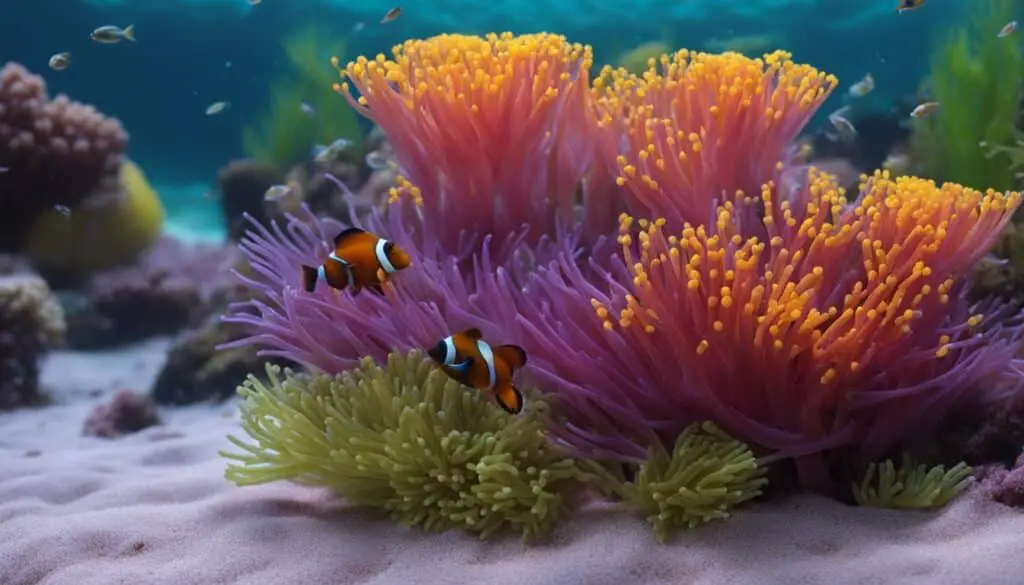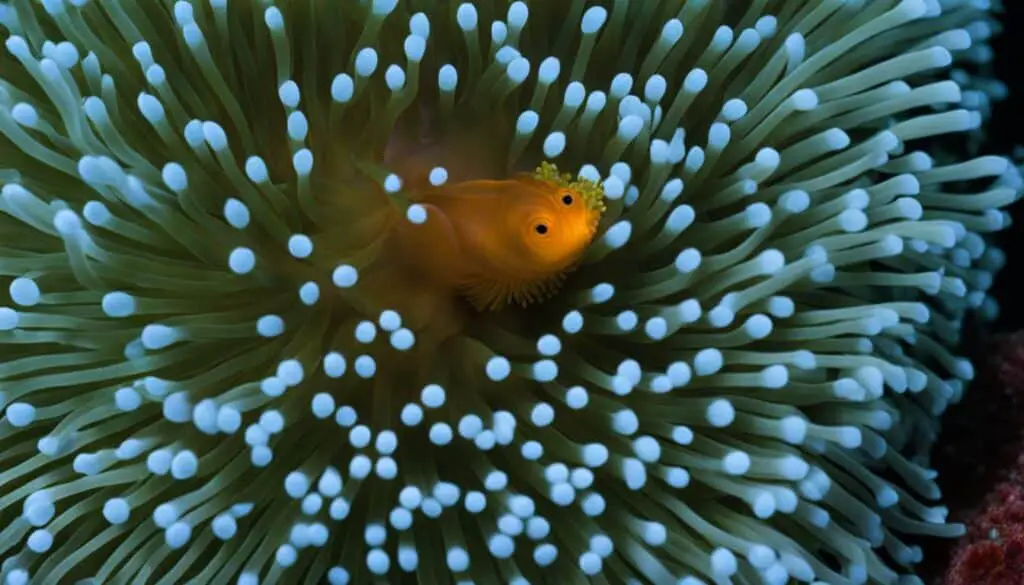Anemone Dynamics: Movement, Behavior, And Marine Adaptations

Anemone Movement And Behavior: Sea anemones are appealing with their unique movement and behavior. These organisms have interested scientists and fans for years, driving investigations into their complex dynamics and environmental relationships.
Key Takeaways:
- Anemones display a dynamic form of mutualism through their hiding behavior, influenced by the behavior of their associated fish.
- Factors such as the number and behavior of commensal fish can impact the timing of anemone hiding.
- Stimuli and environmental factors play a significant role in anemone response, affecting their locomotion and rhythmic movements.
- Anemones possess unique feeding behaviors, using their tentacles armed with nematocysts to capture and immobilize prey.
- Behavioral adaptations, such as retracting tentacles and hiding when not actively feeding, contribute to anemones’ survival and energy conservation.
Anemone Response to Stimuli and Environmental Factors
Sea anemones like Heteractis magnifica react to stimuli and environmental conditions in intriguing ways. Anemones can hide from predators by tensing or retracting their tentacles into their body cavity. This defense system shows anemones’ versatility and self-preservation instinct.
Anemone hiding habit is affected by many elements, including fish quantity and behavior. Anemones with more commensal fish or faster-returning fish emerge from hiding sooner, demonstrating that symbiotic interactions affect their fear response. This complicated dance between anemones and their fish friends shows how marine life dynamics are intertwined and how important it is to investigate these relationships to understand undersea ecosystems.
When stimulated, anemones’ rhythmic movements become more noticeable. Anemones’ rhythmic movements may stimulate their bodies, showing they have sensory perception to comprehend and respond to their surroundings. This delicate ballet of rhythmic movements may expose anemones’ communication, navigation, and mating rituals, showing the aquatic world’s endless mysteries.
Anemone Response to Stimuli and Environmental Factors
As we study anemone mobility and environmental reaction, we appreciate the delicate balance between these species and their environments. The complicated relationship between anemones and their commensal fish and their rhythmic movements illuminate marine life’s fascinating dynamics. Our understanding of anemone behavior can reveal their survival tactics and advance our comprehension of the undersea world.

| Stimuli | Anemone Response |
|---|---|
| Physical disturbance | Tensing or retracting tentacles |
| Presence of associated fish | Emerging from hiding |
| Rhythmic movements | Increased in response to biological stimulation |
Anemone Feeding Behavior and Behavioral Adaptations
Anemones, such as Heteractis magnifica, exhibit fascinating feeding behaviors that contribute to their survival and success in marine environments. These unique behaviors are accompanied by several behavioral adaptations that optimize their feeding efficiency and minimize predation risks.
One of the key aspects of anemone feeding behavior is their use of specialized tentacles armed with nematocysts. When anemones encounter prey, they quickly fire these nematocysts, effectively paralyzing the prey and allowing the anemone to bring it to its mouth. This feeding mechanism ensures that anemones can capture and immobilize a wide range of prey, from small organisms to larger marine animals.
In addition to their feeding mechanisms, anemones also exhibit behavioral adaptations that are specifically tailored to their feeding needs. For instance, anemones have the ability to retract their tentacles and hide when they are not actively feeding. This behavior serves multiple purposes – it conserves energy for the anemone and reduces the risk of attracting predators when prey is scarce.
Overall, anemone feeding behavior and behavioral adaptations play a vital role in their ability to obtain nutrients and thrive in their environment. These fascinating behaviors highlight the complex and dynamic nature of marine life, showcasing the intricate strategies organisms employ to ensure their survival. By studying anemones’ feeding behaviors and adaptations, we gain valuable insights into the broader dynamics of marine ecosystems and deepen our understanding of the interconnectedness of species and their environments.

Key Takeaways:
- Anemones exhibit unique feeding behaviors, using tentacles armed with nematocysts to capture and immobilize prey.
- They have behavioral adaptations, such as retracting their tentacles when not actively feeding, to conserve energy and reduce predation risks.
- Understanding anemone feeding behavior provides insights into the complex dynamics of marine ecosystems and species interactions.
Conclusion
Through a comprehensive exploration of anemone movement and behavior, it is evident that these marine organisms exhibit a range of adaptive behaviors in response to various stimuli and environmental factors. Anemone behavioral adaptations enable them to survive and thrive in their dynamic ecosystems.
The anemone’s rhythmic movements in response to biological stimulation demonstrate their ability to adapt and react to their surroundings. These movements not only serve as a means of communication but also play a crucial role in their feeding behaviors.
By studying individual behaviors, such as the hiding behavior influenced by commensal fish, we gain valuable insights into the intricate dynamics of marine life. Understanding the interplay between anemones and their associated fish provides a deeper understanding of the dynamic nature of mutualistic relationships in the marine environment.
The unique feeding behaviors and adaptations displayed by anemones highlight their remarkable ability to capture and immobilize prey. Their capacity to retract their tentacles and hide when not actively feeding is an energy-saving strategy that reduces the risk of predation.
The study of anemone movement and behavior helps us understand marine ecosystems. We can learn about group-level patterns and interactions by studying individual behaviors. This sheds light on the fascinating world of anemones.
FAQ
What factors influence the hiding behavior of sea anemones?
The hiding behavior of sea anemones is influenced by factors such as the number and behavior of their associated fish. Anemones that have more commensal fish or faster returning fish tend to emerge from hiding sooner.
How do sea anemones respond to stimuli and environmental factors?
Sea anemones respond to various stimuli and environmental factors by exhibiting behaviors such as tensing or withdrawing their tentacles into their body cavity. They also display rhythmic movements in response to biological stimulation.
What feeding behaviors do sea anemones exhibit?
Sea anemones use tentacles armed with nematocysts to capture and immobilize prey. They retract their tentacles and hide when not actively feeding to conserve energy and reduce the risk of predation.
How do sea anemones interact with commensal fish?
Sea anemones have a dynamic mutualistic relationship with their associated fish. The presence and behavior of the fish affect the anemone’s hiding time, with anemones that have more fish or faster returning fish emerging from hiding sooner.
What insights can be gained from studying anemone movement and behavior?
Studying anemone movement and behavior provides valuable insights into the intricate dynamics of marine life. It highlights the importance of understanding individual behaviors to comprehend group-level patterns and interactions.



